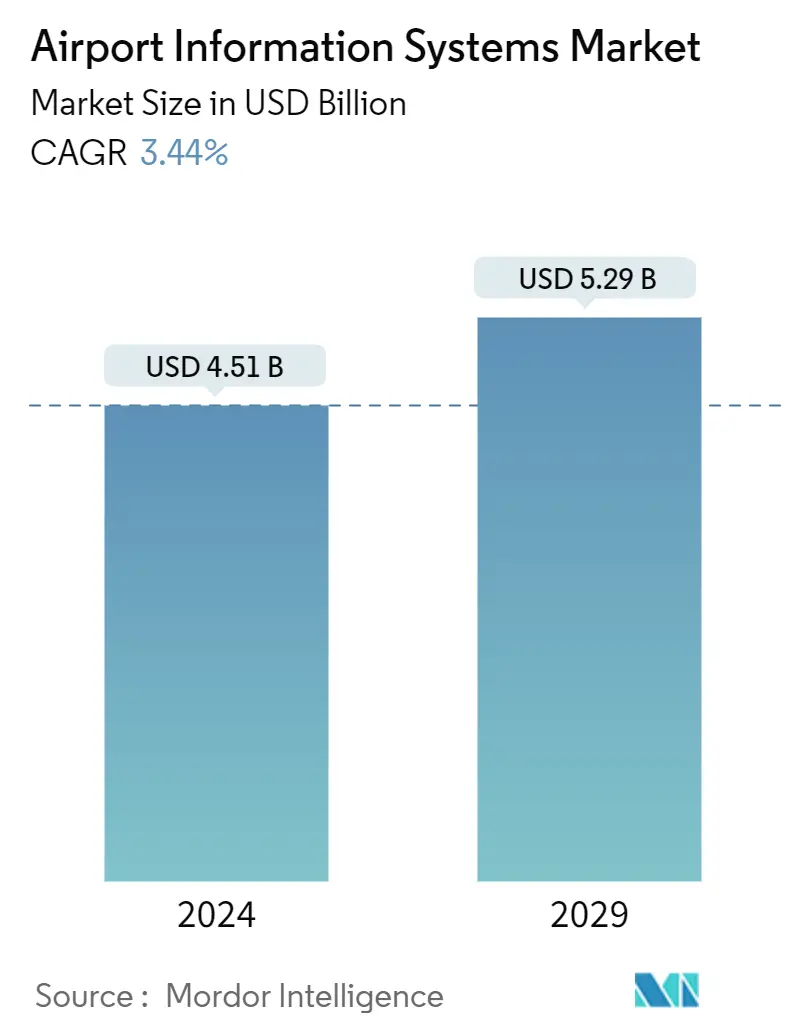Market Size of Airport Information Systems Industry

| Study Period | 2020 - 2029 |
| Market Size (2024) | USD 4.51 Billion |
| Market Size (2029) | USD 5.29 Billion |
| CAGR (2024 - 2029) | 3.44 % |
| Fastest Growing Market | Asia Pacific |
| Largest Market | North America |
Major Players
*Disclaimer: Major Players sorted in no particular order |
Airport Information Systems Market Analysis
The Airport Information Systems Market size is estimated at USD 4.51 billion in 2024, and is expected to reach USD 5.29 billion by 2029, growing at a CAGR of 3.44% during the forecast period (2024-2029).
The COVID-19 pandemic severely impacted global passenger traffic in 2020 and 2021. The aviation industry started improving in 2022 and gradually returned to its pre-COVID-19 level. According to the latest updates from IATA, ICAO, the Airports Council International (ACI), the UN World Tourism Organization (UNWTO), the World Trade Organization (WTO), and the International Monetary Fund (IMF), the international air passenger traffic in 2022 has improved compared to that of 2021. The international air passenger traffic in June 2022 increased by 229.5% compared to June 2021, and the revenue passenger kilometers (RPK) in June 2022 reached 65% of the level in June 2019.
The number of people opting for air travel has increased in the past few years, which has resulted in increased pressure on airports and airlines to opt for advanced systems that can enhance their ground operations and support their goal of reducing aircraft turnaround time. Moreover, to improve efficiency and connectivity, upcoming airports use a variety of technologies, including integrated sensors for temperature and lighting monitoring, smart baggage tags for tracking and directing luggage to the aircraft, biometric check-ins with facial recognition, and cargo warehousing management. Airports are using technologies such as artificial intelligence (AI) and predictive analysis for a wide range of applications, from customer service to operational efficiency. Thus, the integration of such technologies to create an outlook of the operations of an airport and measure performance with associated key performance indicators (KPIs) is anticipated to drive the airport information systems market.
Airports are moving toward centralized architecture to meet the need for information sharing among different parties efficiently. Scanners and monitors are connected to airport systems, and hackers can easily gain access to internal systems through these physical assets. Data from the airport is collected, stored, and distributed daily, based on requirements that are vital for the airport to operate effectively. With regulations and systems becoming more complex, it is a huge task for manufacturers to keep up with appropriate security measures. However, there is a prominent threat of cyberattacks on airports that can lead to widespread disruptions of services. According to a study by the European Aviation Security Agency (EASA), there are an average of 1,000 airport cyberattacks per month. The exploitation of such security vulnerabilities may limit the scope of the integration of airport information systems during the forecast period.
Airport Information Systems Industry Segmentation
An airport information system consists of a set of integrated modules in airport management software that facilitate the operational aspects of the airport.
The airport information systems market is segmented by application, type, and geography. By application, the market is segmented into maintenance, ground handling, finance and operations, security, and passenger information. By type, the market is segmented into the airside and terminal side. Airside operations include air traffic management, aircraft maintenance, and aircraft parking, while terminal-side operations include baggage handling, check-in systems, etc. The report also covers the market sizes and forecasts for the airport information systems market in 18 countries across major regions. For each segment, market sizing and forecasts have been done based on value (USD).
| Application | |
| Maintenance | |
| Ground Handling | |
| Finance and Operations | |
| Security | |
| Passenger Information |
| Type | |
| Airside | |
| Terminal Side |
| Geography | |||||||
| |||||||
| |||||||
| |||||||
| |||||||
|
Airport Information Systems Market Size Summary
The airport information systems market is poised for growth, driven by the increasing demand for advanced technologies to enhance airport operations and passenger experiences. As air travel continues to rebound from the impacts of the COVID-19 pandemic, airports are under pressure to adopt sophisticated systems that improve efficiency and reduce turnaround times. This includes the integration of technologies such as artificial intelligence, biometric check-ins, and smart baggage tracking, which are becoming essential for modern airport operations. The shift towards centralized architectures and the need for robust information sharing among various stakeholders are also propelling the market forward. However, the threat of cyberattacks poses significant challenges, necessitating stringent security measures to protect these systems.
The Asia-Pacific region is a key driver of growth in the airport information systems market, with numerous construction and modernization projects underway. Countries like China and India are leading the charge with ambitious plans to expand their airport infrastructure, creating substantial opportunities for system integrators. The market is characterized by a semi-consolidated landscape, with major players such as Honeywell International, Amadeus IT Group, SITA, RTX Corporation, and THALES playing pivotal roles. These companies are increasingly partnering with hardware manufacturers to offer comprehensive solutions that meet the evolving demands of the aviation sector. The focus on smart technologies and digital transformation is expected to further boost the adoption of airport information systems, as evidenced by successful implementations in various airports worldwide.
Airport Information Systems Market Size - Table of Contents
-
1. MARKET DYNAMICS
-
1.1 Market Overview
-
1.2 Market Drivers
-
1.3 Market Restraints
-
1.4 Porter's Five Forces Analysis
-
1.4.1 Threat of New Entrants
-
1.4.2 Bargaining Power of Buyers/Consumers
-
1.4.3 Bargaining Power of Suppliers
-
1.4.4 Threat of Substitute Products
-
1.4.5 Intensity of Competitive Rivalry
-
-
-
2. MARKET SEGMENTATION
-
2.1 Application
-
2.1.1 Maintenance
-
2.1.2 Ground Handling
-
2.1.3 Finance and Operations
-
2.1.4 Security
-
2.1.5 Passenger Information
-
-
2.2 Type
-
2.2.1 Airside
-
2.2.2 Terminal Side
-
-
2.3 Geography
-
2.3.1 North America
-
2.3.1.1 United States
-
2.3.1.2 Canada
-
-
2.3.2 Europe
-
2.3.2.1 Germany
-
2.3.2.2 United Kingdom
-
2.3.2.3 France
-
2.3.2.4 Italy
-
2.3.2.5 Rest of Europe
-
-
2.3.3 Asia-Pacific
-
2.3.3.1 China
-
2.3.3.2 India
-
2.3.3.3 Japan
-
2.3.3.4 South Korea
-
2.3.3.5 Rest of Asia-Pacific
-
-
2.3.4 Latin America
-
2.3.4.1 Brazil
-
2.3.4.2 Rest of Latin America
-
-
2.3.5 Middle East and Africa
-
2.3.5.1 United Arab Emirates
-
2.3.5.2 Saudi Arabia
-
2.3.5.3 Egypt
-
2.3.5.4 Qatar
-
2.3.5.5 Rest of Middle East and Africa
-
-
-
Airport Information Systems Market Size FAQs
How big is the Airport Information Systems Market?
The Airport Information Systems Market size is expected to reach USD 4.51 billion in 2024 and grow at a CAGR of 3.44% to reach USD 5.29 billion by 2029.
What is the current Airport Information Systems Market size?
In 2024, the Airport Information Systems Market size is expected to reach USD 4.51 billion.

